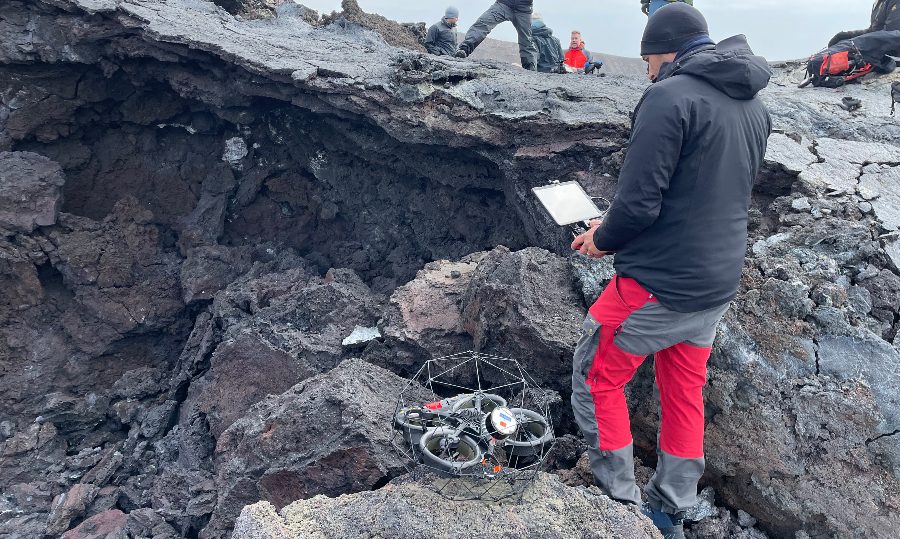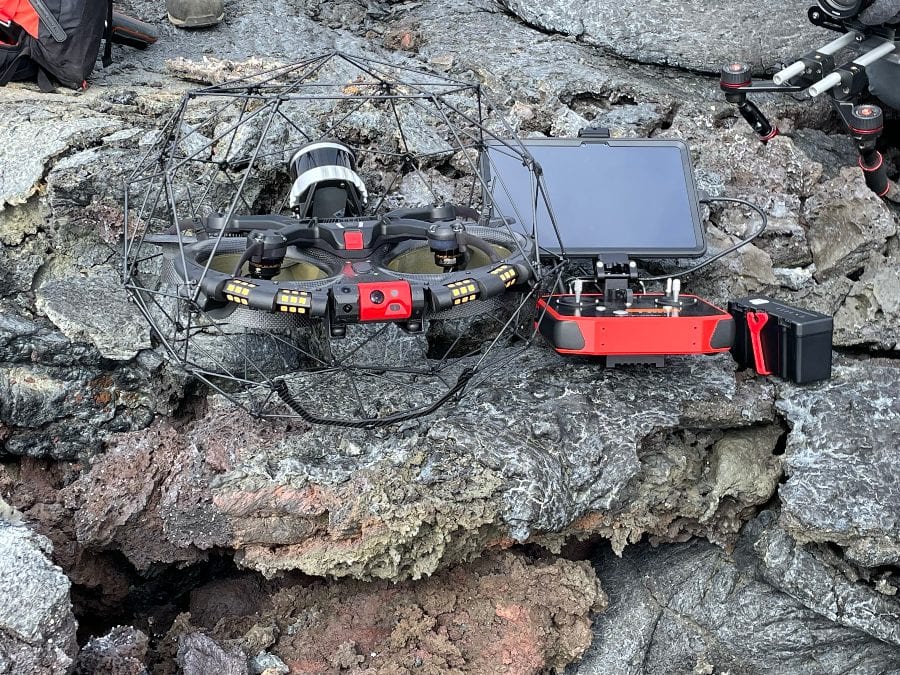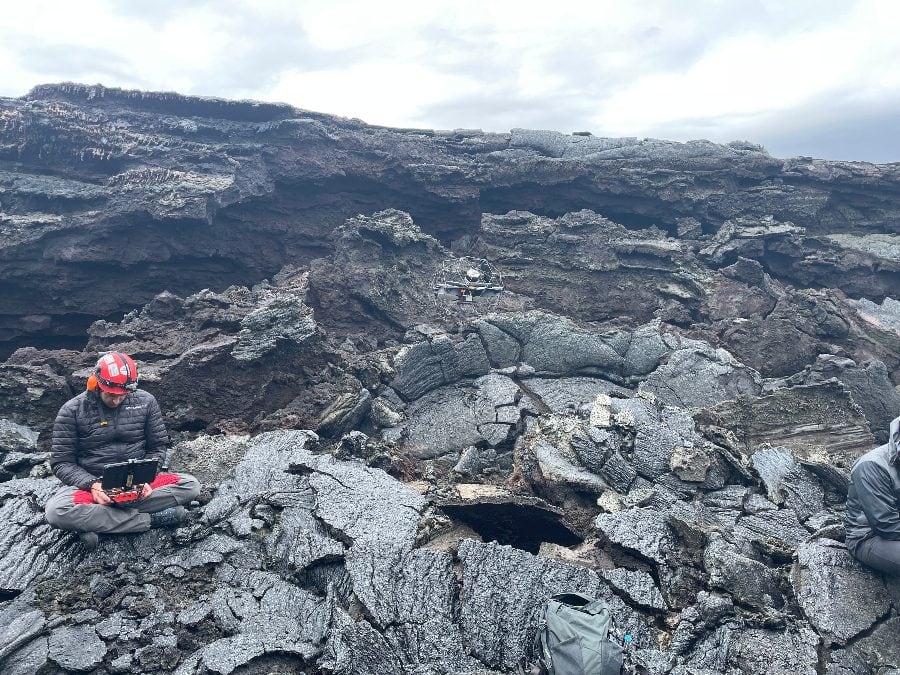3D Maps of Lava Tubes by Drone—A Mission to Iceland’s Fagradalsfjall Volcano with the Elios 3
BY Zacc Dukowitz
25 May 2022Pilots from Flyability were in Iceland last week just a few days before the launch of the company’s new indoor drone, the Elios 3.
They were there to support research being conducted by La Venta, a scientific organization based in Italy that specializes in studying caves.

Flyability’s Charles Rey prepares for a flight with the Elios 3 on the volcano
Flyability has partnered with La Venta several times in the past, including on a mission to Greenland that was documented in this video:
The expedition team was fairly large, and included four people from Flyability, nine from La Venta, and three from Ouster, makers of the LiDAR sensor that goes on Flyability’s new drone.
Mapping Lava Tubes on the Fagradalsfjall Volcano
One of the main objectives of the trip was to use Flyability’s Elios 3 to make 3D maps of lava tubes found on the Fagradalsfjall Volcano. The Elios 3 is a new indoor drone that carries a LiDAR sensor, allowing it to make 3D maps in real time, as it’s flying.
A lava tube is a tunnel or channel within a solidified lava flow that’s created by molten lava flowing through an area—imagine the tracks that water running through dirt makes, but on a massive scale.


Flyability’s Elios 3
The Fagradalsfjall Volcano was active as recently as last September, and the La Venta team was eager to be there as the area was still cooling.
The name of the volcano might sound familiar—when it was active last fall, several drone pilots did kamikaze missions as it was erupting, capturing epic footage of plumes of magma shooting into the sky. Some barely made it out with their footage, while others lost their drones to the volcano.


Watch this video on YouTube
The La Venta team was full of seasoned researchers and explorers, and included several speleologists (cave researchers), mapping experts, geologists, and a logistics expert to help with planning.
The expedition’s purpose was to study the lava tubes that formed after the magma cooled following the eruption. There were three areas of focus for this research:
1. Space Exploration
Lava tubes present environments that are similar to those you might find on Mars and the moon. By improving our understanding of them, we can help prepare for future space travel to these and other extraterrestrial destinations.
2. New Minerals
New minerals might be formed in the extreme conditions found during and after a volcanic eruption—minerals that may disappear as the magma cools. La Venta researchers wanted to see if they could find any unusual minerals present within the lava tubes and caves formed by the cooling magma.
3. The Return of Life
Finally, the La Venta team wanted to see how quickly life returns following a volcanic eruption. Any signs of life returning to the landscape would be of interest for the expedition.
Flying an Indoor Drone in a Lava Tube
At the first lava field the team arrived at, you could see clouds of sulfur wafting up from vents in the hardened lava.
The surface of the lava was incredibly unstable, and would often break under your feet as you walked across it. The entire area felt like it was in transition, on its way to some new state with nothing stable anywhere you stepped.
In the caves and lava tubes that La Venta wanted to research, temperatures can fluctuate wildly, going from 50 degrees to 230 degrees Fahrenheit in just six inches. Using drone technology inside lava tubes is still a fairly new idea, and this trip was the first time that Flyability’s technology had been tested inside these extreme environments.


Flying the Elios 3 inside a cave at the Fagradalsfjall Volcano
On the first flight, the Flyability team learned about these temperature fluctuations the hard way when an Elios 2 suddenly encountered a spike in heat to over 220 degrees, and dropped to the ground. La Venta team members carefully climbed down to retrieve the drone, and the effort took up most of our first day.
But they soon got the hang of it, and successfully flew several missions with the Elios 3. By the end of the three-day mission, nine 3D maps of lava tubes and caves had been created.


Credit: Flyability
What’s Next?
Now that the data has been collected, the La Venta team will study the 3D maps of the tubes to see what they can learn.
Both the Flyability and Ouster teams collected a lot of footage documenting the mission and plan to partner on a series of short videos highlighting the mission and La Venta’s research.
After the volcano mission, the team went on to meet reporters from Vice News who joined them for an expedition to the Vatnajökull Glacier in the south of Iceland. As Flyability launched the Elios 3 last Thursday, the expedition team was undergoing its first day of research on the glacier.
La Venta’s goal for the glacier mission was to use the Elios 3 to study changes to ice caves found on the glacier. This data can help researchers understand how climate change is accelerating the rate of glacial melt, and how that melt might in turn impact the rising of the ocean.
Vice plans to release a short documentary about the glacier expedition—here’s a teaser Vice just put out highlighting the mission:
@viceworldnews We visited Europe’s largest #glacier in #Iceland to see the effects of #climatechange. #drone #droneshot #dronetiktok ♬ original sound – VICE World News


